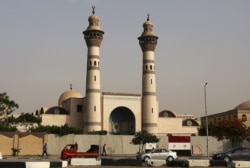The recent decapitation of a French schoolteacher in a Parisian suburb over showing caricatures of Prophet Muhammad to his class is the latest in a series of violent attacks in recent years over depictions of Islam’s holiest figure.
Some experts charge that illustrations and paintings have long been a controversial topic in Islam because the Quran does not say anything about it, leaving it open to numerous fatwas or religious ruling by different Islamic schools.
The fatwas that exist on illustration art range from extreme ones that forbid the depiction, and even photography, of any living organism, to more moderate ones that find certain artwork acceptable. Some more progressive views in the religion maintain that there is nothing wrong with portraying anyone, including Prophet Muhammed.
Al-Azhar view
A thousand-year-old institution, Egypt’s al-Azhar University is widely considered as Sunni Islam’s most prestigious center to issue fatwas.
The institution's grand Imam, Sheikh Ahmad al-Tayeb, has condemned the beheading of Samuel Paty, the French teacher, and Thursday's knife attack that killed three people in Nice as "heinous terrorist attacks" that contradict Islam.
At the same time, al-Tayeb has said that using free speech as a justification to insult religions was an "invitation to hatred."
In a January 2018 response to a follower’s question on Facebook, al-Azhar University provided what appeared to be an inconclusive ruling on whether drawing pictures of humans was allowed in Islam.
In a video explanation, the center noted a disagreement among Muslim jurists throughout history on depicting living beings, saying that some credible scholars have imposed an absolute ban on it, viewing the art as usurping God’s power.
“Those who draw pictures will be punished on the Day of Resurrection; and it will be said to them: 'Breathe soul into what you have created,’ ” said the center, quoting a hadith or teaching by the prophet.
The center, however, said it was supporting the view that drawings are acceptable as long as they are not made to be worshiped or to challenge God’s power.
“When people saw images or statues in the 7th century, they could have been tempted to worship them,” Mustafa Akyol, a senior fellow at the Cato Institute focusing on Islam and modernity, told VOA. “Today, the idea probably doesn’t occur to anyone.”
Idol worship has long been a concern among Muslims, whose first enemies included Meccan paganists worshiping deities. To this day, there appears to be a bigger consensus among Muslims against three-dimensional illustrations because they appear more likely to be worshiped than the two-dimensional ones, according to experts.
In 2006, al-Azhar ruled that the ancient sculptures that contribute to Egypt’s multibillion-dollar tourism sector are forbidden in Islam.
If drawing any living being is banned, then a depiction of Prophet Muhammad would constitute an even bigger crime, say ultra-conservative clerics, whose fatwas are usually cited by extremist groups such as the Islamic State and the Taliban.
No picture of Muhammad in mosques
Unlike Christian churches, where portraits of Jesus Christ and Virgin Mary are ubiquitous, mosques do not display any pictures of Prophet Muhammad, despite the fact that Muslims don’t see him as divine but rather as God’s human messenger.
In Shi'ite mosques, drawings of Prophet Muhammad’s close companions and relatives, such as Ali Ibn Abi Talib, the Prophet’s cousin and son-in-law, are common.
Historians say depictions of Islam’s leader have not always been frowned upon, pointing to paintings of him during the 13-16th century by artists from modern-day Turkey and Iran.
One of the most prominent such portraits is on display at the New York-based Metropolitan Museum of Art. It is a 16th-century painting showing Prophet Muhammad on the back of a four-legged animal with the face of a human, a central Islamic belief known as “the heavenly journey of the Prophet.”
No capital crime
Depicting Prophet Muhammad is not a capital crime, according to Ali al-Qaradaghi, an influential Sunni Muslim cleric who serves as secretary-general of the Qatar-based International Union of Muslim Scholars (IUMS).
“Drawing a portrait of prophet Muhammed, peace be upon him, could, at maximum, be a minor sin; it’s not kabaeer,” Qaradaghi told VOA by phone, using an Arabic word meaning a capital sin. “It’s not considered a crime by the Sharia.”
Qaradaghi said Muslims viewed the depictions of Prophet Muhammad in the caricatures by French satirical newspaper Charlie Hebdo as blasphemous because they were offensive not merely because they showed Islam’s holiest man.
"In Islam, things are judged based on their outcome,” he said. “For example, if you do something that will have a positive outcome, then you can do it. If, on the other hand, it’s something that is offensive and insulting to someone, even if it’s a proper thing to do, it would still be considered an improper thing to do.”
Washington, D.C.-based Pew Research Center shows that most Muslim nations have laws against blasphemy, with some countries such as Pakistan and Saudi Arabia enforcing the death penalty. Insulting Prophet Muhammad in both verbal and nonverbal ways, such as in a caricature, are widely considered blasphemous.
Muslim artists and filmmakers have in recent decades avoided showing Prophet Muhammad’s face in their works on Islam’s inception years. In a 1976 movie called “ar-Risalah” (or The Messenger), Muhammad was shown only as a shadow.










